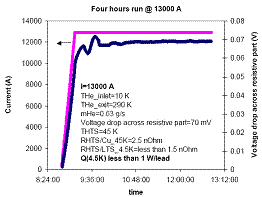| Introduction |
| Physics of HTS |
| HTS materials |
| HTS leads |
| Resistive leads |
| Other activities |
| Contracts |
| Publications |
LHC HTS Current leads
|
The LHC will require the transfer of more than 3 MA of current for the powering of the superconducting magnets operating at superfluid helium temperature. About 26 % of this current is transported by leads feeding the main dipole and quadruple magnets (13000 A), 54 % by leads powering the insertion magnets (3400 A-6800 A), 17 % by leads for the corrector magnet circuits (600 A) and the remaining 5 % by leads for the dipole corrector magnets (60 A-120 A). Prior to starting the design of the LHC leads, a study was made to evaluate the exergetic costs of different cooling methods available within the already well-defined infrastructure of the LHC machine, and the potential saving in liquefaction power induced by the use of HTS material. The most convenient solution, finally adopted for all the LHC HTS current leads, consists in cooling the resistive part of the lead with 20 K/1.3 bar helium gas, recovered from the LHC beam screen cooling line, while the HTS element operates in self-cooling conditions between an intermediate temperature (THTS) and the 4.5 K liquid helium bath. The estimated saving in total cooling power with respect to conventional self-cooled current leads, which conduct into the helium bath about 1.1 W/kA, corresponds to 30 % while the heat load into the liquid helium is reduced by a factor greater than 10. These values were confirmed by several measurements performed at CERN on prototype leads. It was decided to integrate HTS material in all the current leads transporting currents ranging from 600 A to 13000 A. The LHC HTS current leads operate in a temperature range between room temperature and the saturated liquid helium bath. They consist of a resistive section, convection cooled by helium gas available in the LHC machine at a nominal temperature of about 20 K, and a superconducting section, self-cooled by the vapour generated by the lead itself at 4.5 K. The two circuits are hydraulically separated. The warm end of the superconducting section, THTS, is maintained at 70 K in stand-by operation and at 50 K in operation with current. Integrated within the current lead body is the instrumentation required for its operation and protection: a platinum sensor, at the top of the HTS unit, used for the control of the 20 K helium mass flow rate, and the voltage taps which are provided for independent protection of the resistive (100 mV threshold) and HTS part (5 mV threshold). Additional voltage taps are made available for the protection of the magnet circuits. The detailed design of the leads was made at CERN, where the prototype units were also tested in cryogenic conditions. The leads are grouped in three different series, designed for operating respectively at 13000 A, 6000 A and 600 A. A pre-series of 140 units was manufactured and assembled at CERN. The complete series of leads is being manufactured in CECOM, Rome, for the 13000 A leads and in the Russian laboratory of BINP, Novosibirsk, for the 6000 A and 600 A current leads, on the basis of CERN "build-to-print" designs. All HTS current leads are measured at maximum current prior to installation in the LHC machine: the laboratory of ENEA, Frascati, measures the series of 13000 A and 6000 A HTS current leads, while the University of Southampton measures the series of 600 A HTS current leads. The 13000 A and 6000 A current leads are manufactured as single units, while the 600 A current leads are assembled in a group of four on a common insulating flange. The table below summarizes the typical performance of the three different type of leads when operating at maximum current, as already repeatedly measured on hundred of units.
|
13000 A Heat exchanger |
| last changed: 2005-11-23 | webmaster: Amalia Ballarino |

